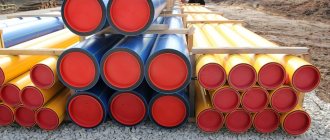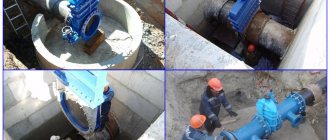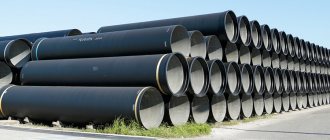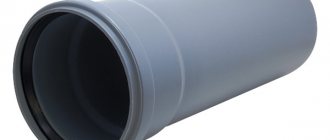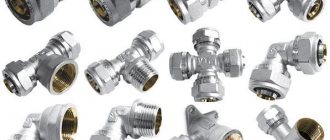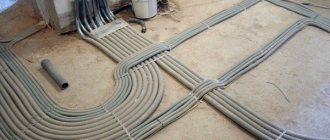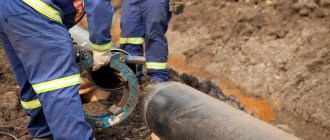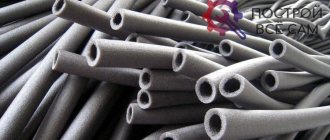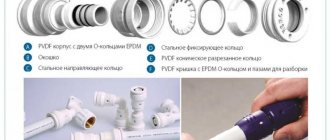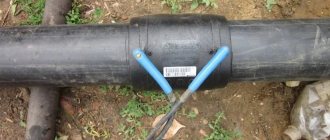Polymer pipes are widely used for the construction of pipelines for various purposes. These include PVC pipes. They have numerous advantages, including the following advantages over their steel counterparts:
- high resistance to aggressive liquids and negative environmental influences;
- no problem of corrosion, including electrochemical;
- simplicity and high speed of installation;
- light weight;
- low heat capacity, which protects pipelines from temperature changes;
- environmental safety of the material;
- high maintainability of pipelines made of PVC pipes, etc.
At the same time, the low melting point of PVC pipes limits their use for cold water supply pipelines (including from wells) and sewerage (domestic, industrial and storm water).
The temperature of liquids and working media should not exceed 60–80 °C, depending on the purpose of the pipelines. PVC itself melts at a temperature of about 150 °C, but pipes made from it lose their properties at lower temperatures.
Polyvinyl chloride: features and properties
PVC is a class of plastic that remains recyclable after the forming process is complete, including pipes. The material begins to melt at a temperature of 165-200 C, and is almost not subject to deformation, including mechanical stress. Such properties are provided due to the structure of polyvinyl chloride and its molecular structure.
To fully understand what a PVC pipe is, you need to add that it is a non-flammable product that is resistant to many acids, chlorinated, aromatic and aliphatic carbohydrates. The material itself is thermoplastic, can be easily machined, and to weld it, heating up to 200-300 C is sufficient.
Compared to the strength of the material, this indicator for joints, regardless of the method of their creation (gluing, welding), reaches about 85-90%. Due to the property of non-conductivity of electric current, polyvinyl chloride is a good dielectric and is used for the manufacture of smooth electrical products. It should be noted that the polymer loses this property when heated above 85 C.
PVC electrical pipes are used as protection against various types of damage to computer, electrical and television cables. Due to chlorine in the polymer, the latter has good fire resistance. The melting point of products made from this material is superior to polypropylene or polyethylene analogues.
Material of manufacture
The first to make such tape was the American company 3MSpam, which at that time produced adhesive tape, reflective film and other materials. The first materials were polyvinyl chloride and the plasticizer tricresyl phosphate. The sample turned out to be working, but the tape quickly became oily, losing its adhesive properties. Until now, PVC tape has been modified 17 times.
Nowadays, to make insulation, they use plasticized polyvinyl chloride film, on which a layer of glue is applied. The latter comes in two types: rubber, which makes the tape more durable, and acrylic, which improves its “sticking” property. Acrylic glue, in turn, is more resistant to sunlight.
The sleeve for the tape can be plastic or cardboard. The more common type is made from cardboard - this type of insulation has two layers of glue and a primer between them.
PVC pipes: features, characteristics
Pipes are manufactured in accordance with state standards:
- R 51613-2000 – production of products;
- R 52134-2003 – terminology;
- 18599-2001 - characteristics of PVC pipes by size.
Products made from polyvinyl chloride are resistant to deposit accumulation and have high elasticity. They do not rust and have a smooth surface on the inside, which ensures pressure stability, eliminating its decrease. In the case of an electrical pipe (grey/white), this allows the cable to be pulled through without any obstruction.
UV rays, microorganisms and stray currents also do not pose a threat to such products. A white pipe is used when the insulation of an electrical wire is damaged as a protective measure against electric shock.
Polyethylene
Two subtypes of material are used: LDPE (high-density polyethylene) and HDPE (low-density polyethylene). Production is regulated by GOST 22689-77, GOST 22689.2-89, GOST 18599-2001 and local regulatory documents - TU (technical conditions).
It is advisable to operate polyethylene at t≤40°C. Short-term (up to 5 minutes) exposure to heat at 60–65°C will not lead to changes in mechanical characteristics. A further increase in thermal or time parameters will lead to loss of shape and a decrease in strength properties. The average melting point is 120°C.
Classification of PVC pipes
Currently, several types of such products are produced from polyvinyl chloride, each of which has its own classification characteristics, including technical/operational characteristics, appearance and other indicators.
There are three types of smooth PVC products:
- sewer (external/internal);
- casing;
- electrical.
Sewer pipes are divided into two subtypes - external and internal - depending on the location of the system. Thanks to the characteristics of products for internal sewerage systems, it becomes possible to use them for draining wastewater from households and apartments. External pipes are used for water inlet structures and the construction of sewer networks with a large cross-section.
Depending on the bending radius, such pipes can be:
- flexible;
- very flexible;
- tough.
Depending on the standard size, there are small, medium and large products.
They are also divided according to the type of working environment they serve:
- non-pressure (transportation without pressure);
- pressure (transportation under pressure);
- for rarefied environments.
In addition, corrugated products can be two-layer: they consist of a smooth inner and corrugated outer layer.
The range of polyvinyl chloride pipes is determined by state standard 28117-89. The documents also contain detailed information about the material, requirements for the production process, use of products, technical/operational parameters and properties, interpretation of marking symbols and other necessary data.
A little history
At the end of the Soviet era, despite the global shortage, microdistricts of houses were built in the regions of the Far East according to a standard design, popularly called Leningradsky.
During the construction of these houses, an attempt was made to reduce the cost of construction. The walls of the houses were made of panels, but the windows were triple glazed. The heating devices are convectors of a strange design, a curved pipe with an internal diameter of no more than 20 mm with thin steel plates tightly strung on it.
The Far Eastern climate is harsh, with winter temperatures dropping below -30⁰C. When there is a strong wind, the heat loss of a panel house becomes simply enormous and tiny convectors, designed for completely different operating conditions, simply cannot cope with the task. In order to somehow compensate for heat loss, it was necessary to increase the temperature of the coolant beyond 100⁰С, fortunately the parameters of the heating mains allowed this.
Water with such indicators, entering the internal hot water supply system, is simply bound to damage the polypropylene pipeline. However, this does not happen. The fact is that the temperature that a polypropylene pipe can withstand is somewhat underestimated. Any manufacturer, indicating the operating temperature of a polypropylene pipe in the characteristics, leaves a reserve in case of unforeseen circumstances, laying out straws to avoid litigation.
This allows for some deviation in the production of different batches of polypropylene pipes, without sending them to the ranks of defective products. Their thickness, the strength of the plastic itself and other physical properties may differ slightly.
When talking about what temperature a polypropylene pipe can withstand, it is worth mentioning one factor that influences what pressure a polypropylene pipe can withstand (for more details: “What pressure can polypropylene pipes withstand - types and uses”).
Currently, pipes marked PN20 and PN25 are common. Their difference is that the latter are reinforced with fiberglass or aluminum foil.
Flexible pipes made of polyvinyl chloride: features and characteristics
The technical characteristics of a number of such products depend on the properties of the main material from which they are made - polyvinyl chloride. The difference between these pipes is their high ring stiffness, thanks to which they are able to withstand significant pressure (upper limit 120 atmospheres). Elongation when heating the pipe reaches 5%.
The disadvantages of the material include low frost resistance, which requires the use of thermal insulation. At a temperature of 15 C below zero, such a product loses its properties. Read also: “Features of CPVC pipes and rules for their use.”
Flexible pipes are available in various colors, including transparent, due to the high light transmittance of the polymer. PVC products are more resistant to UV rays than their plastic counterparts. As for the surface of flexible pipes, it is smooth on the inside and outside. A decrease in the rigidity of such pipes is observed at temperatures above 78C above zero.
Pressure
An important parameter that is displayed in the markings of all pipes. He talks about the nominal pressure that the pipes can withstand inside, provided that the water temperature is 20 degrees. The pipes can regularly withstand this pressure for 50 years without changing their performance characteristics.
Pressures in the marking are indicated by the letters PN and a number that corresponds to bars. The larger the number after the letters PN, the thicker the pipe walls. The most popular pipeline options are marked PN 10, 16, 20 and 25.
PVC square pipes
Square products have a wall of 2-3 mm. Thanks to their convenient shape, the widespread use of PVC pipes is justified; in particular, they are used for the construction of greenhouses, greenhouses, nipple watering systems and others. In the case of greenhouses, they are connected into a frame and then attached to a wooden foundation.
Unlike round pipes, a pipeline made of square products reliably holds the entire system in a vertical position. The installation of the nipple requires special attention, which must be perpendicular to the line of the square pipe.
The range includes the production of products in a wide variety of wall thicknesses and sizes. Please note that the standards do not prohibit coloring profiles by adding pigment. In this way, orange or white pipes are made.
Double-glazed window formula: let's start decoding.
What is the most important thing in PVC windows? Of course, energy saving. And it is the double-glazed window that provides it, and not the profile at all.
Do you want to be sure that you bought energy-saving PVC windows?
Look carefully at the glass unit formula, which a specialist from a company installing plastic windows must provide you with when calculating the structure.
A 2-chamber double-glazed window with 2 energy-saving layers and internal filling with argon gas in this calculation will be “prescribed” as follows: 4i-14Ar-4-14Ar-4i or 4i-12Ar-4-16Ar-4i.
How to decipher this set of numbers and letters?
4 - glass thickness. The unit of measurement is millimeters. Important! In a 2-chamber double-glazed window there are 3 glasses installed, in a single-chamber one - 2. Another “chamber” is by analogy.
PVC socket pipes
The main difference between these products and other types is the presence of a socket with a sealing ring. Due to the design features, it is possible to eliminate the use of welding machines during the installation of the system. Like PVC pipes, socket pipes are used for water supply. They are also used for sewer networks.
The main material for their production is unplasticized polyvinyl chloride, which has high strength and resistance to aggressive environments.
When such pipes are joined with other products, a connection is formed whose density allows it to withstand low and high pressure in the pipeline. A large assortment is another advantage of bell-shaped products made of polyvinyl chloride.
Technological process of welding PP
Welding polypropylene pipes is based on the ability of this type of plastic to soften when heated to a certain temperature, acquiring a state similar to soft plasticine. When two molten parts come into close contact, a process of mutual penetration (diffusion) of materials occurs, resulting in a strong connection that is not inferior in durability to the entire structure.
There are two main methods of connecting polypropylene pipes: butt and coupling. In the first option, the ends of the parts are heated simultaneously with a special disk soldering iron, after which they are joined together; this technology is widely used when joining large-diameter pipes in industrial construction.
When using polypropylene pipes of small diameters (up to 63 mm) in the construction industry for laying water supply and heating networks, the butt method is absolutely unsuitable for the following reasons:
- welding of polypropylene pipes of only one diameter can be realized;
- after joining, a convex seam is formed inside the pipeline, reducing the cross-section of the passage channel - this significantly increases the hydraulic resistance of a small-diameter pipeline and reduces the efficiency of its use, increasing the likelihood of blockages.
- the connection has less strength than a coupling connection.
Soldering technology using couplings consists of using a transition piece (a section of a conventional single-layer PP pipe) with an internal diameter corresponding to the outer diameter of the pipe sections being connected to join pipes. To carry out the work, a special soldering iron is used to simultaneously heat the outer surface of the pipe and the internal adapter coupling, after which the parts are quickly connected manually. A similar procedure with heating of the coupling and the outer pipe shell is carried out with the second section to be joined. It is clear that after insertion into the coupling, the ends of both pipe sections are almost connected end-to-end without a convex seam, and if you use an adapter with different diameters, you can join pipelines of any size.
Rice. 5 Soldering plastic pipes - technological process
Criteria and features for choosing PVC pipes
The main characteristics of each product are indicated in the labeling, which does not require any special knowledge to decipher.
As a rule, it contains the following information:
- wall thickness;
- type of polyvinyl chloride;
- outside diameter;
- state standard (in accordance with which the pipe is manufactured);
- size ratio;
- appointment;
- type of bell.
What does the color of the pipe mean? It contains information about the use of the product:
- blue/white – used for casing wells;
- yellow/orange – used for the construction of external networks;
- gray/black corrugated - intended for use in the construction of internal sewer systems.
On the inside, corrugated pipes are light gray or white. Detailed information about the characteristics of the product is contained in the documents in accordance with which it was manufactured.
Depending on their strength indicators, pipes are divided into:
- lungs (indicated by the letter L);
- medium (marked with Latin N);
- heavy (designated as S).
Based on the strength class, the maximum depth of the pipe when laying the pipeline underground is calculated. For example, the designation of a light group as SN-2 indicates that it is capable of withstanding 2 kN/m2, medium SN-4 and heavy SN-8 - 4 kN/m2 and 8 kN/m2, respectively.
For the laying of above-ground pipelines and cables, as a rule, black polyvinyl chloride products are used, since the latter tends to reduce exposure to UV rays.
Soldering table for polypropylene pipes depending on the diameter of the pipes
| D products, mm | Operating t | Soldering period, s | Required warm-up time from initial 6s | Cooling period, min |
| 20 | 259-280 | 4 | 0 | 2 |
| 25 | +1 | 3 | ||
| 32 | +2 | 4 | ||
| 40 | 5 | +6 | 4 | |
| 50 | +12 | 5 | ||
| 63 | 6 | +18 | 6 | |
| 75 | +24 | 6,5 |
This is interesting: How to measure the diameter of a pipe with a tape measure
Application of PVC pipes
The technical characteristics of such pipes have ensured their widespread use in various fields, each of which is determined by the type of product. These are used as the basis for municipal water supply, where the permissible upper limit of the temperature of the working fluid reaches 45 C. They are also used for the construction of domestic sewage systems (pressure, gravity).
Reinforced PVC products are a spiral-shaped frame that is filled with polymer. They are widely used in equipment with high levels of vibration (this applies not only to industrial units, but also to household appliances). The main purpose of reinforced PVC pipes in equipment is to provide reliable protection of the power circuit under conditions of prolonged vibration loads.
Due to the design features, such products have increased strength along with flexibility. This structure makes it possible to expand the range of applications of such pipes, for example, in cases where long-term static loads are involved. Thus, when protecting electrical networks, external laying of reinforced PVC products is used, while in building materials - hidden and underground. In addition, they are used in areas where turns and bends are required (due to the flexibility of the pipes).
Smooth, rigid PVC pipe is widely used in the construction of sewer networks and laying electrical cables. If we are talking about open cable wiring along the base (all degrees of flammability), then a light series is used. In addition, it is suitable for hidden cable laying in horizontal and vertical surfaces of the room. The heavy series is used in cement and concrete screeds for indoor use.
Naturally, before choosing a specific type of PVC pipe, you should familiarize yourself with the characteristics of the products and other information that influences the choice. It is important to be able to correctly decipher the markings and understand what the color of the pipe means. The range of products allows you to choose an option taking into account specific requirements and conditions.
Purpose
Due to its versatility, this material is used in various areas of human activity. It is applicable both outdoors and indoors. In stores you can find ribbons of different colors, but the main thing is that they do not have any unpleasant odors - this indicates low quality.
PVC tape is not recommended for insulating polymers or silicone surfaces that contain fluorine. If the surface to be treated has defects, pores or other damage, it must first be prepared by applying a primer material. PVC tape is applied only to a dry and clean surface.
- work with electrical engineering. Electrical cables are insulated with tape, wires are connected, and bundles are marked;
- household work. PVC tape is useful if you need to repair various things, from tools to other household items;
- car repair. For example, if necessary, insulate wires and other places;
- package. Thanks to the adhesive coating, this tape makes it easy to pack small boxes. Packaging work is increasingly being automated;
- boat repair. To do this, use a special reinforced tape;
- pipeline protection. Pipes laid in the ground are constantly affected by the negative influences of the soil, so pipelines require reliable protection. PVC insulation helps protect the outside of pipes from rust. But here it is important to use it correctly, namely, wind it in a spiral to avoid distortions. The tape, resistant to moisture, waterproofs the highways.
This is not the entire list of areas where electrical tape is used. In addition to repair work, it is also widespread in creative activities.
Which heating stage becomes critical?
In the context of this situation, it is worth understanding that the thermal indicators declared by the manufacturer do not limit the technical capabilities of the product in question. The indicated parameters are optimal and harmless for structural parts, and in the case of intense heating for a short period of time at a temperature exceeding the declared one, no significant consequences will occur, but if the undesirably high temperature lingers for a long time, then there is a high probability of deformation and even gusts.
